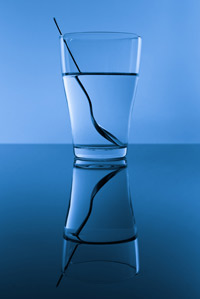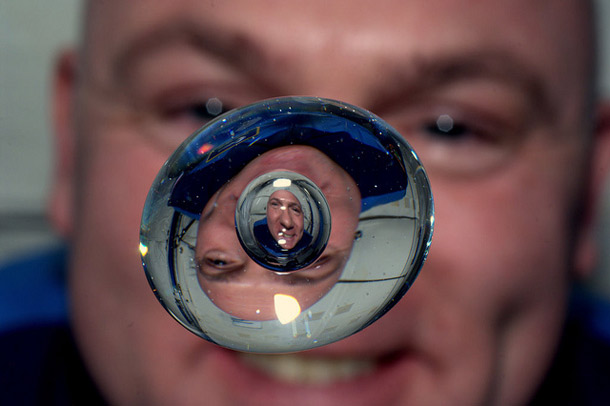A light bending exercise... in space!

On board the International Space Station, ESA astronaut André Kuipers just put up this ridiculously cool and fun picture of himself playing with water in space:
Wheee! But what are you seeing?
SCIENCE!
Let me explain.
The really short version of this is that the water is acting like a lens, flipping his face over. But there are two images of André's face in there, and one is upside down! What gives?
First we need to look a the drop itself. On Earth, sitting on a surface like a tabletop, water drops tend to be flattened. But in space, where gravity's not an issue, water drops form little spheres. That's because of surface tension, an imbalance in the electromagnetic forces between water molecules, and is a whole post all by itself! But for now, what you need to know is that in orbit where there's no net effect from gravity, water droplets form little balls.
In this case, you can see the drop isn't a perfect sphere; it's big enough that it can oscillate like a spring, elongating in one direction. That's cool, but doesn't affect what's going on here too much -- it just elongates the image of his face seen in the drop a little bit.
But we're not done! The astronauts injected an air bubble into the drop. On Earth, that bubble would rise and pop, but again, when gravity isn't your master, the bubble stays put. So in the middle of the water drop is an evacuated sphere filled with air.
So what's with the funhouse mirror stuff?
 Ah, that's because light can be bent! When a beam of light passes through water or some other transparent material, the direction it's traveling changes, which is why a spoon sitting in a glass of water looks like someone bent it. This is called refraction, and depends on two different things: the material itself (different stuff bends light by different amounts) and the direction from which the light hits it.
Ah, that's because light can be bent! When a beam of light passes through water or some other transparent material, the direction it's traveling changes, which is why a spoon sitting in a glass of water looks like someone bent it. This is called refraction, and depends on two different things: the material itself (different stuff bends light by different amounts) and the direction from which the light hits it.
The shape of the refracting material -- the lens -- also changes the image we see coming from the source. The curvature of the lens affects the direction the light is bent. In the case of light coming from outside a sphere of water, the light hitting the top of the drop gets bent down, light hitting the right bends left, and so on.
And one other thing: the path of light bends whenever it passes from one medium to another, so it bends if it's going through air and then hits water, and it also bends if it's going through water and hits air!
So now we can figure this all out. We see André's face right side up in the background. As light coming from the top of his head hits the top of the drop, it gets bent down. Light from the bottom of his gets bent up. Light from the left side of his face is bent right, and from the right bent left. So in the water drop itself we see his face upside down, and switched left-to-right.
But that same light is also passing through the water into the air bubble. This reverses the reversal! For example: light from the top of his head hits the water and bends down. But some of that light hits the air bubble, and gets bent up. This counteracts the first affect, flipping the image rightside-up.
So the net effect is that light that comes from André and goes just through water gets flipped over and reversed. Light that goes through the water and the air bubble gets flipped again, fixing everything. Because the air bubble isn't a perfect sphere, his face is a little distorted, but I hope you can -- haha! Ha! -- get the picture.
Now imagine that he could inject a second, tinier drop of water into the air bubble. We'd see a third, teenier image of his face, and flipped upside down again! And then an air bubble in that would flip it again, and then...
OK, I think you've got it.
My point in all this? Even something as simple as a drop of water gets complicated when you look at it carefully, and in a different environment. Also, the picture you have of the Universe around you may be bent in some ways that don't always seem obvious at first glance.
When you look around you, how many lenses -- both physical and mental -- are distorting your view?
Image credits: ESA/NASA; Shutterstock (alexsalcedo)
Related Posts:
- Squishy Moonrise seen from space
- Mistical Moonrise time lapse
- Ring around the Moon
- Naked rainbows





























